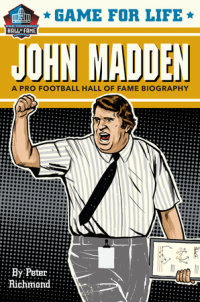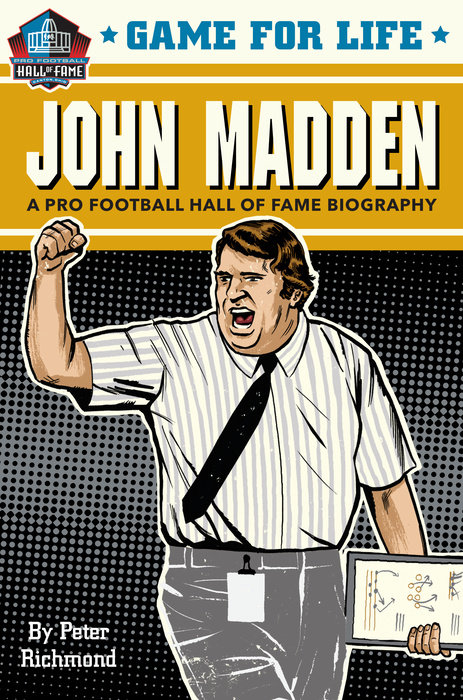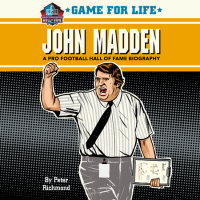It’s not every kid who has a playing field named after him. Then again, it’s not every kid who loves football so much that he’d jump onto a moving freight train to get up to San Francisco to see his beloved San Francisco 49ers play. Or hitchhike to their training camp. Or hop a moving streetcar to catch a San Francisco Seals baseball game.
It’s not everyone who loves sports so much that his whole world revolved around them when he was a kid.
And a teenager. And even now, as an adult.
It’s not every guy who’s been lucky enough to keep playing his whole life.
But John Madden has.
↔↔↔
He was born in 1936 in Austin, Minnesota. When Madden was a young boy, his family moved to Daly City, California, where his father, an auto mechanic, got work at a Chevrolet dealership. Daly City was an industrial town—and a great place for a sports-loving kid to grow up in. It lay just south of San Francisco,…
It’s not every kid who has a playing field named after him. Then again, it’s not every kid who loves football so much that he’d jump onto a moving freight train to get up to San Francisco to see his beloved San Francisco 49ers play. Or hitchhike to their training camp. Or hop a moving streetcar to catch a San Francisco Seals baseball game.
It’s not everyone who loves sports so much that his whole world revolved around them when he was a kid.
And a teenager. And even now, as an adult.
It’s not every guy who’s been lucky enough to keep playing his whole life.
But John Madden has.
↔↔↔
He was born in 1936 in Austin, Minnesota. When Madden was a young boy, his family moved to Daly City, California, where his father, an auto mechanic, got work at a Chevrolet dealership. Daly City was an industrial town—and a great place for a sports-loving kid to grow up in. It lay just south of San Francisco, home to the National Football League’s 49ers and the Pacific Coast League’s Seals.
Better yet, it was a town with a large municipal park full of ball fields, although the truth was that Madden and his friends spent most of their time in the humble patch of ground next to his family’s home on Knowles Street.
The kids called it Madden’s Lot—as in, “We’ll meet after school at Madden’s Lot.”
“I thought it was my lot,” Madden said. “I really did. You didn’t know who owned things in those days. I thought I owned it. It’s there, you play.”
It wasn’t much of a field: packed dirt, maybe sixty feet wide, a hundred feet long, not a lot of grass.
“It was a terrible lot,” his lifelong friend John Robinson said. “It was all weeds. Every time I go to a restaurant now and I see Field Greens as an expensive salad on the menu, I think of being tackled facedown with a mouthful of field greens as a kid.”
Madden’s Lot sloped a little downward. If you and your friends were playing football, and your side had the ball, and you were pretending to be, say, 49ers star running back Hugh McElhenny, the best play would be going downhill on a power sweep to the right.
For baseball, home plate was on the low side, and if you were Seals outfielder Neill Sheridan, your hit could clear Knowles Street. But if you pulled it too far left, you’d hit the Madden house.
“We’d break windows all the time, the dining room and kitchen,” Madden said. “But my mom didn’t say a word. My dad never said a word, either. That was a gift. I was lucky. It was never, ‘You can’t play anymore; don’t break the window anymore.’ He’d just fix it.
“Then he finally put chicken wire on the windows. I mean, he knew I couldn’t tell my buddies, ‘Let’s play in Madden’s Lot, but you can’t break a window.’ ”
↔↔↔
Daly City had one cool thing going for it that a lot of cities don’t: it was right on the ocean. You could smell the sea, especially when the fog rolled in.
“Daly City was the fog capital of the world,” Madden said. At least that’s what it felt like to the young boy. “I grew up in fog. I love fog. You know why? You never get tired in fog. You can play all day. We’d play early in the morning before school, then it’d burn off, then after school, it came back, and you could play in the fog again. . . . The fog was great for endurance.”
The science behind Madden’s fog theory might be a little suspect, but whatever the reason, it seemed as if he could play his sports forever. This meant, of course, that being a kid was not about grammar school at Our Lady of Perpetual Help, where Madden was never a top student. “I always made fun of the people who sat in front, the people who, when the nuns would ask a question, they’d be waving their hands.
“I never waved my hand. I just sat in back and talked about other stuff until I got in trouble, yeah. You’d go to the principal’s office and whack!”
Grade school was about waiting: for recess, so he could play; for lunch, so he could play; and for the final bell, so he could play.
“If it was football season, we were Forty-Niners,” Robinson said. “If it was baseball, we were Yankees. Basically, when we were little kids, you’d start playing at nine in the morning and go home either when the sun went down or you got so hungry you couldn’t stand it anymore.”


